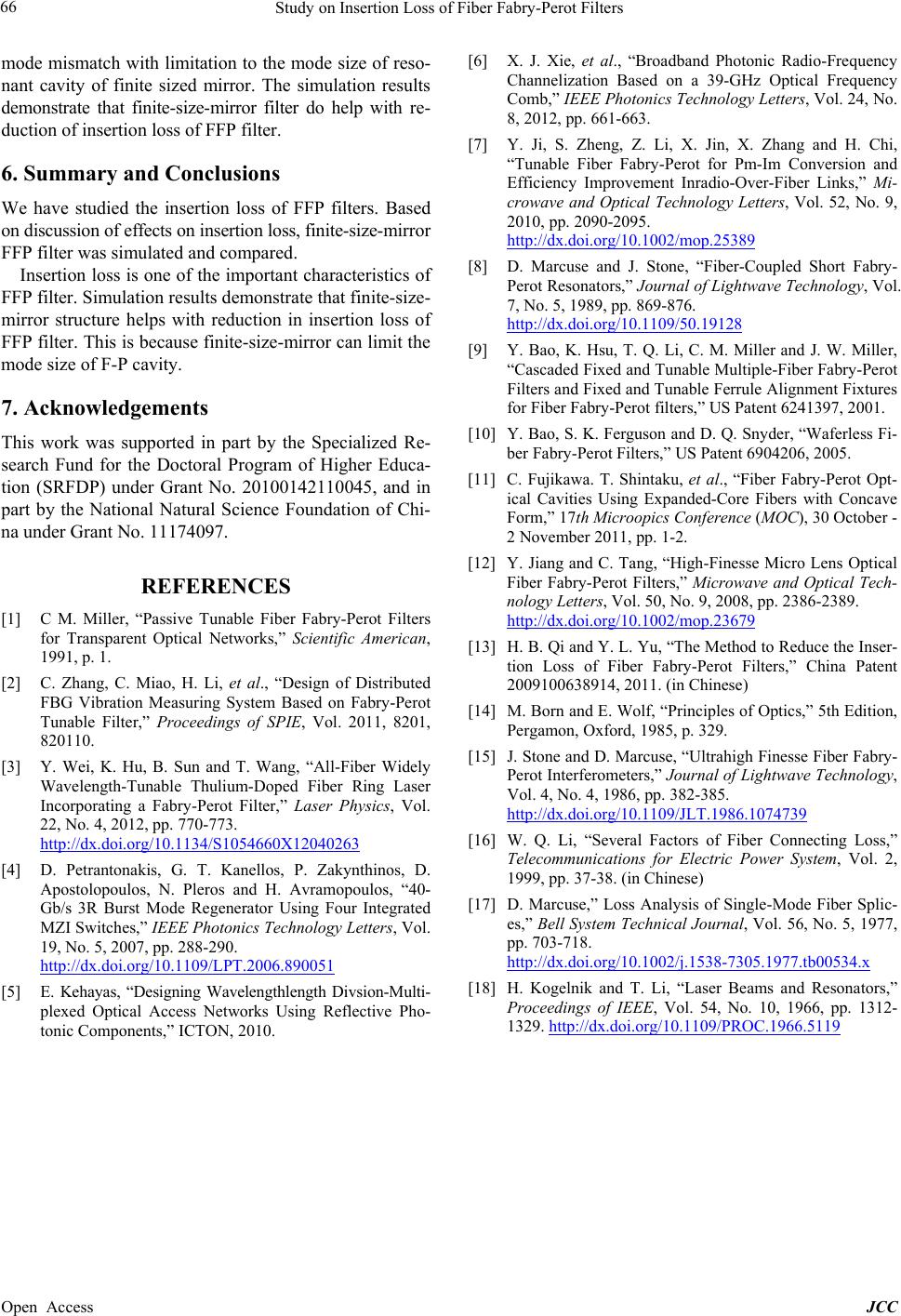
Study on Insertion Loss of Fiber Fabry-Perot Filters
Open Access JCC
mode mis match with limitation to the mode size of reso-
nant cavity of finite sized mirror. The simulation results
demonstrate that finite-size-mirror filter do help with re-
duction of insertion loss of FFP filter.
6. Summary and Conclusions
We have studied the insertion loss of FFP filters. Based
on discussion of effects on insertion loss, finite-size-mirror
FFP filter was simulated a nd compared.
Insertion loss is one of the important charac teristics of
FFP filter. Simulation results demonstrate that finite-size-
mirror structure helps with reduction in insertion loss of
FFP filter. This is because finite-size-mirror can limit the
mode size of F-P cavity.
7. Acknowledgements
This work was supporte d in part by the Specialized Re-
search Fund for the Doctoral Program of Higher Educa-
tion (SRFDP) under Grant No. 20100142110045 , and in
part by the National Natural Science Foundation of Chi-
na under Grant No. 11174097.
REFERENCES
[1] C M. Miller, “Passive Tunable Fiber Fabry-Perot Filters
for Transparent Optical Networks,” Scientific American,
1991, p. 1.
[2] C. Zhang, C. Miao, H. Li, et al., “Design of Distributed
FBG Vibration Measuring System Based on Fabry-Perot
Tunable Filter,” Proceedings of SPIE, Vol. 2011, 8201,
820110.
[3] Y. Wei, K. Hu, B. Sun and T. Wang, “All-Fiber Widely
Wavelength-Tunable Thulium-Doped Fiber Ring Laser
Incorporating a Fabry-Perot Filter,” Laser Physics, Vol.
22, No. 4, 2012, pp. 770-773.
http://dx.doi.org/10.1134/S1054660X12040263
[4] D. Petrantonakis, G. T. Kanellos, P. Zakynthinos, D.
Apostolopoulos, N. Pleros and H. Avramopoulos, “40-
Gb/s 3R Burst Mode Regenerator Using Four Integrated
MZI Switches,” IEEE Photonics Technology Letters, Vol.
19, No. 5, 2007, pp. 288-290.
http://dx.doi.org/10.1109/LPT.2006.890051
[5] E. Kehayas, “Designing Wavelengthlength Divsion-Multi-
plexed Optical Access Networks Using Reflective Pho-
tonic Components,” ICTON, 2010.
[6] X. J. Xie, et al., “Broadband Photonic Radio-Frequency
Channelization Based on a 39-GHz Optical Frequency
Comb,” IEEE Photonics Technology Letters, Vol. 24, No.
8, 2012, pp. 661-663.
[7] Y. Ji, S. Zheng, Z. Li, X. Jin, X. Zhang and H. Chi,
“Tunable Fiber Fabry-Perot for Pm-Im Conversion and
Efficiency Improvement Inradio-Over-Fiber Links,” Mi-
crowave and Optical Technology Letters, Vol. 52, No. 9,
2010, pp. 2090-2095.
http://dx.doi.org/10.1002/mop.25389
[8] D. Marcuse and J. Stone, “Fiber-Coupled Short Fabry-
Perot Resonators,” Journal of Lightwave Technology, Vol.
7, No. 5, 1989, pp. 869-876.
http://dx.doi.org/10.1109/50.19128
[9] Y. Bao, K. Hsu, T. Q. Li, C. M. Miller and J. W. Miller,
“Cascaded Fixed and Tunable Multiple-Fiber Fabr y-Perot
Filters and Fixed and Tunable Ferrule Alignment Fixtures
for Fiber Fabry-Perot filters,” US Patent 6241397, 2001.
[10] Y. Bao, S. K. Ferguson and D. Q. Snyder, “Waferless Fi-
ber Fabry-Perot Filters,” US Patent 6904206, 2005.
[11] C. Fujikawa. T. Shintaku, et al., “Fiber Fabry-Perot Opt-
ical Cavities Using Expanded-Core Fibers with Concave
Form,” 17th Microopics Conference (MOC), 30 October -
2 November 2011, pp. 1-2.
[12] Y. Jiang and C. Tang, “High-Fi nesse Micro Lens Optical
Fiber Fabry-Perot Filters,” Microwave and Optical Tech-
nology Letters, Vol. 50, No. 9, 2008, pp. 2386-2389.
http://dx.doi.org/10.1002/mop.23679
[13] H. B. Qi and Y. L. Yu, “The Method to Reduce the Inser-
tion Loss of Fiber Fabry-Perot Filters,” China P atent
2009100638914, 2011. (in Chinese)
[14] M. Born and E. Wolf, “Principles of Optics,” 5th Edition,
Pergamon, Oxford, 1985, p. 329.
[15] J. Stone and D. Marcuse , “Ultrahigh Finesse Fiber Fabry-
Perot Interferometers,” Journal of Lightwave Technology,
Vol. 4, No. 4, 1986, pp. 382-385.
http://dx.doi.org/10.1109/JLT.1986.1074739
[16] W. Q. Li, “Several Factors of Fiber Connecting Loss,”
Telecommunications for Electric Power System, Vol. 2,
1999, pp. 37-38. (in Chinese)
[17] D. Marcuse,” Loss Analysis of Single-Mode Fiber Splic-
es,” Bell System Technical Journal, Vol. 56, No. 5, 1977,
pp. 703-718.
http://dx.doi.org/10.1002/j.1538-7305.1977.tb00534.x
[18] H. Kogelnik and T. Li, “Laser Beams and Resonators,”
Proceedings of IEEE, Vol. 54, No. 10, 1966, pp. 1312-
1329. http://dx.doi.org/10.1109/PROC.1966.5119